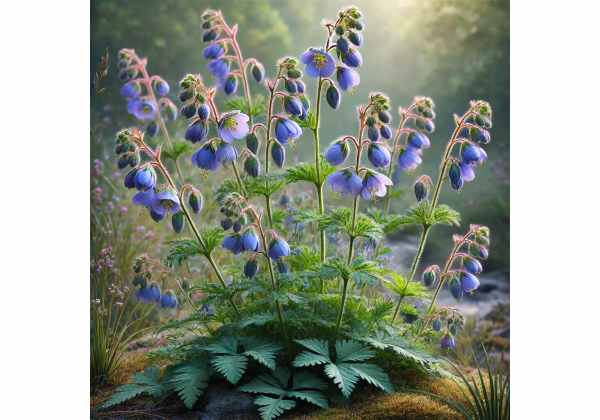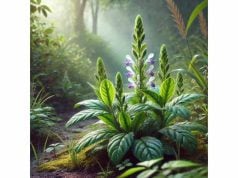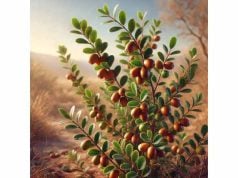
Jacob’s ladder is a captivating perennial herb valued in traditional medicine and modern herbal research. Known for its ladder-like, compound leaves and delicate clusters of blue or white flowers, this herb has been used to promote overall wellness, support respiratory and digestive health, and act as a gentle diuretic. With a rich profile of bioactive compounds—including antioxidants, flavonoids, and saponins—Jacob’s ladder offers a multifaceted approach to health improvement. In this comprehensive guide, we explore its botanical identity, detailed phytochemical makeup, therapeutic benefits, practical applications, and the latest scientific research, providing you with an all-encompassing resource on this intriguing herb.
Table of Contents
- Botanical Overview and Identification
- Chemical Composition and Active Constituents
- Health Advantages and Core Qualities
- Practical Applications and Safety Guidelines
- Research Insights and Key Findings
- Frequently Asked Questions
Botanical Overview and Identification
Jacob’s ladder, commonly known by its botanical name Polemonium caeruleum (though several species share the common name), is a herbaceous perennial belonging to the family Polemoniaceae. Native to temperate regions of Europe and Asia, this plant thrives in well-drained meadows, woodland edges, and alpine pastures. Its distinctive ladder-like arrangement of pinnate leaves not only gives the herb its common name but also creates an elegant display when combined with its clusters of star-shaped blue or white flowers.
Taxonomy and Morphological Features
- Kingdom: Plantae
- Clade: Angiosperms
- Clade: Eudicots
- Order: Ericales
- Family: Polemoniaceae
- Genus: Polemonium
- Species: P. caeruleum (one representative species)
Jacob’s ladder typically grows to a height of 30–90 centimeters. The leaves are deeply divided into numerous lanceolate leaflets, creating a structure that resembles the rungs of a ladder. The foliage is a vibrant green in spring and summer, providing a striking contrast to its pale blue or occasionally white flowers. These flowers are borne in loose, airy clusters and open in the early morning, attracting a variety of pollinators, including bees and butterflies.
Growth Conditions and Habitat
This herb prefers moist, well-drained soils and can often be found in semi-shaded areas where it receives ample sunlight but is protected from the harshest midday heat. It is well-adapted to a range of soil types—from sandy loams to richer, clayey soils—thanks to its extensive root system that efficiently extracts moisture and nutrients. Jacob’s ladder is often used as an ornamental plant in rock gardens and naturalized landscapes due to its aesthetic appeal and ease of cultivation.
Ecological and Cultural Significance
In its native habitat, Jacob’s ladder plays an important ecological role by providing nectar and pollen to a host of pollinators, which in turn support local biodiversity. Historically, it has been revered in traditional European herbal medicine for its reputed benefits in aiding digestion, alleviating respiratory complaints, and acting as a mild diuretic. Cultural lore even associates the plant with spiritual journeys and ascension, echoing the biblical imagery of Jacob’s ladder as a bridge between heaven and earth.
Gardeners and herbalists prize Jacob’s ladder for its dual function as both an ornamental and medicinal herb. Its resilience to various environmental conditions and low maintenance requirements make it a popular choice for sustainable landscaping. Modern horticulturists continue to explore its potential, with breeding programs aimed at enhancing its flower color and overall vigor.
Propagation and Cultivation Practices
Jacob’s ladder is typically propagated through seed, though division of established clumps is also common. Germination can be slow and may require a period of cold stratification to mimic natural winter conditions. Once established, the plant multiplies readily and forms attractive, spreading clumps. In garden settings, it benefits from regular watering and occasional fertilization during the growing season. Mulching can help retain soil moisture and suppress weeds, ensuring optimal growth conditions.
The adaptability and visual appeal of Jacob’s ladder make it a frequent subject of botanical studies and conservation projects. As habitats continue to change with climate variability, understanding its ecological preferences is key to preserving both its natural populations and its utility in garden landscapes.
In summary, the botanical profile of Jacob’s ladder highlights a plant of both beauty and practical value. Its distinctive morphology, adaptability to varied environments, and rich cultural history make it an essential component of traditional herbal medicine and modern horticulture alike. This comprehensive identification sets the stage for a deeper exploration into its chemical makeup and subsequent health benefits.
Chemical Composition and Active Constituents
Jacob’s ladder is prized not only for its visual appeal but also for its rich and diverse phytochemical profile. The herb contains a complex array of bioactive compounds that contribute to its medicinal properties and overall health benefits. In this section, we explore the key constituents found in Jacob’s ladder, detailing their structures, functions, and potential applications.
1. Flavonoids
Flavonoids are among the most abundant compounds in Jacob’s ladder. These polyphenolic molecules exhibit strong antioxidant properties.
- Key Compounds: Quercetin, kaempferol, and apigenin.
- Biological Effects: These flavonoids help scavenge free radicals, reduce oxidative stress, and exert anti-inflammatory effects. They are known to support cardiovascular health and may play a role in neuroprotection.
- Potential Uses: Due to their ability to modulate inflammatory responses, flavonoids are being investigated for their therapeutic potential in treating chronic inflammatory diseases.
2. Phenolic Acids
Phenolic acids complement the antioxidant profile of Jacob’s ladder.
- Examples: Caffeic acid, ferulic acid, and gallic acid.
- Mechanism of Action: These compounds contribute to the reduction of oxidative stress by neutralizing harmful free radicals and enhancing the body’s antioxidant defense systems.
- Health Benefits: Their presence is associated with reduced risks of chronic diseases such as cancer and heart disease, and they support skin health by promoting collagen synthesis.
3. Triterpenoids
Triterpenoids are bioactive compounds that have been linked to various pharmacological activities.
- Function: They are known for their anti-inflammatory, antimicrobial, and hepatoprotective properties.
- Research Insights: Studies suggest that triterpenoids can help modulate immune responses and may serve as potential therapeutic agents for inflammatory and metabolic disorders.
- Applications: Their use in herbal formulations is being explored for conditions such as liver dysfunction and chronic inflammation.
4. Saponins
Saponins are naturally occurring glycosides with a wide range of biological activities.
- Properties: They have cholesterol-lowering effects and contribute to the anti-inflammatory and immune-enhancing properties of the herb.
- Benefits: Saponins can help improve digestive health and support cardiovascular function by modulating lipid metabolism.
- Usage: These compounds are often extracted for use in nutraceutical supplements aimed at promoting heart health and overall vitality.
5. Alkaloids (in Trace Amounts)
Although present in smaller quantities, alkaloids in Jacob’s ladder can be significant for their bioactivity.
- Role: They may contribute to the herb’s mild sedative and nerve-calming effects.
- Potential Applications: Research into these alkaloids is still ongoing, but initial findings suggest they could support cognitive function and alleviate mild anxiety.
6. Essential Oils and Volatile Compounds
The essential oil profile of Jacob’s ladder includes a variety of volatile compounds that contribute to its aroma and therapeutic properties.
- Composition: The oils contain monoterpenes and sesquiterpenes.
- Therapeutic Effects: These compounds are known for their antimicrobial and anti-inflammatory properties and may be used in aromatherapy to promote relaxation and respiratory health.
- Practical Uses: They can be incorporated into topical applications and diffusers for holistic wellness.
Synergistic Interactions
The diverse range of bioactive constituents in Jacob’s ladder does not act in isolation; instead, these compounds work synergistically to enhance the overall therapeutic effect of the herb. The combination of potent antioxidants, anti-inflammatory agents, and supportive phytochemicals creates a holistic matrix that may contribute to improved cellular function and overall health. This synergy is a key factor in the efficacy of whole-herb preparations compared to isolated compounds.
Standardization and Extraction
Modern extraction techniques strive to preserve the delicate balance of bioactive compounds in Jacob’s ladder. Standardized extracts ensure that the therapeutic properties of the herb are maintained consistently across different batches. Techniques such as cold extraction and ethanol extraction are commonly used to obtain high-quality extracts while minimizing the degradation of sensitive phytochemicals.
In conclusion, the chemical composition of Jacob’s ladder reveals a wealth of bioactive compounds that underpin its medicinal and nutritional benefits. Understanding these components provides a solid foundation for appreciating the herb’s multifaceted role in promoting health, setting the stage for a discussion of its specific health benefits in the next section.
Health Advantages and Core Qualities
Jacob’s ladder offers an impressive spectrum of health benefits, thanks to its rich blend of antioxidants, anti-inflammatory agents, and other bioactive compounds. This section details the herb’s key health advantages, exploring how its unique chemical profile translates into tangible benefits for various body systems.
Antioxidant Protection and Anti-Aging
The robust antioxidant activity of Jacob’s ladder helps protect cells from oxidative damage.
- Mechanism: Flavonoids, phenolic acids, and carotenoids in the herb neutralize free radicals, thereby reducing oxidative stress.
- Benefits: This protection supports cellular health, delays the aging process, and helps prevent degenerative diseases such as cancer and cardiovascular disorders.
- Skin Health: Enhanced antioxidant activity promotes collagen synthesis and protects the skin against environmental damage, contributing to a youthful appearance.
Anti-Inflammatory Effects
Chronic inflammation is a common contributor to many health issues. Jacob’s ladder exhibits significant anti-inflammatory properties:
- Key Compounds: The anti-inflammatory effects are primarily mediated by flavonoids, triterpenoids, and saponins.
- Impact: These compounds help reduce the production of pro-inflammatory cytokines and inhibit inflammatory pathways, thereby alleviating symptoms of conditions such as arthritis, inflammatory bowel disease, and respiratory ailments.
- Long-Term Benefits: Regular use of Jacob’s ladder may contribute to overall reductions in chronic inflammation, promoting long-term health.
Digestive Health and Detoxification
High in dietary fiber and bioactive enzymes, Jacob’s ladder supports a healthy digestive system.
- Fiber Content: The fiber aids in regulating bowel movements, preventing constipation, and promoting a healthy gut microbiome.
- Detoxification: Enhanced digestive function helps the body eliminate toxins more efficiently, contributing to overall detoxification and improved metabolism.
- Gut Health: Prebiotic effects from the fiber content foster beneficial gut bacteria, further enhancing digestive and immune function.
Immune System Support
The potent combination of vitamins, antioxidants, and phytochemicals in Jacob’s ladder bolsters the immune system.
- Immune Cell Function: Antioxidants such as vitamin C and polyphenols enhance the activity of immune cells, aiding in the prevention of infections.
- Anti-Microbial Properties: Certain bioactive compounds exhibit antimicrobial effects, providing a natural defense against pathogens.
- Resilience: Regular consumption of the herb can improve overall immune resilience, reducing the incidence of common colds and other minor infections.
Cardiovascular and Metabolic Benefits
Jacob’s ladder contributes to cardiovascular health through several mechanisms:
- Cholesterol Regulation: Phytosterols and fiber help lower LDL cholesterol levels, reducing the risk of atherosclerosis.
- Blood Pressure Support: The mineral content, including potassium, aids in maintaining healthy blood pressure levels.
- Metabolic Support: B vitamins present in the herb support energy metabolism and help regulate blood sugar levels, making it beneficial for managing metabolic disorders.
Neurological and Cognitive Benefits
Emerging research suggests that the antioxidant and anti-inflammatory properties of Jacob’s ladder may also support cognitive function.
- Neuroprotection: By mitigating oxidative stress and reducing inflammation, the herb may help protect against neurodegenerative diseases.
- Cognitive Enhancement: Some traditional uses include improving mental clarity and reducing mild anxiety, potentially due to the synergistic effects of its bioactive compounds.
- Mood Support: The calming effects of certain phytochemicals may contribute to overall mood stabilization and stress reduction.
Additional Health Promoting Qualities
Jacob’s ladder has been traditionally used for a variety of additional health purposes:
- Respiratory Support: Its mild expectorant properties help relieve congestion and promote clearer breathing.
- Diuretic Effects: The herb can help increase urine flow, assisting in the elimination of excess fluids and toxins from the body.
- Bone and Joint Health: Some compounds may aid in the maintenance of healthy joints and bones by reducing inflammation and supporting tissue repair.
Collectively, these health advantages highlight the versatility of Jacob’s ladder as a natural remedy. Whether used as a dietary supplement, herbal infusion, or incorporated into modern nutraceutical formulations, its core qualities make it an appealing option for holistic health management.
Practical Applications and Safety Guidelines
Jacob’s ladder is utilized in various forms across culinary, medicinal, and cosmetic applications. Its versatility, however, necessitates careful consideration regarding preparation, dosage, and potential interactions. This section provides practical guidance for incorporating Jacob’s ladder into daily routines while ensuring safe and effective use.
Culinary Applications
Jacob’s ladder is occasionally used in culinary practices, particularly in traditional herbal teas and infusions.
- Herbal Teas: Dried leaves of Jacob’s ladder can be steeped in hot water to make a soothing herbal tea, reputed to support digestive and respiratory health.
- Salads and Garnishes: Young leaves may be incorporated into salads for a mild, herbal flavor, adding both visual appeal and nutritional benefits.
- Smoothies and Extracts: In modern kitchens, extracts or powdered forms of the herb can be added to smoothies to boost antioxidant intake.
Medicinal and Nutraceutical Uses
Jacob’s ladder has a long history in herbal medicine and continues to be explored for its therapeutic properties.
- Infusions and Decoctions: Traditional preparations involve simmering the herb’s leaves in water to extract its active compounds. These decoctions are used to alleviate digestive disturbances and mild respiratory issues.
- Tinctures and Extracts: Alcohol-based tinctures offer a concentrated form of the herb’s active constituents. Standardized extracts are available in capsule or liquid form and are often marketed for their antioxidant, anti-inflammatory, and immune-supportive benefits.
- Dosage Recommendations: While traditional use suggests a cup of herbal tea or 1–2 mL of tincture taken two to three times daily, modern supplements should be used according to the manufacturer’s guidelines. Consultation with a healthcare provider is advised for individualized dosage, particularly for those with underlying health conditions.
Cosmetic and Topical Applications
The anti-inflammatory and antioxidant properties of Jacob’s ladder make it a valuable ingredient in skincare products.
- Anti-Aging Creams: Extracts rich in polyphenols and flavonoids are incorporated into anti-aging formulations to protect the skin from free radical damage and promote collagen production.
- Soothing Lotions: Topical applications may be used to soothe irritated or inflamed skin, making them useful in products designed for sensitive skin.
- Usage Guidelines: When applying Jacob’s ladder extracts to the skin, a patch test is recommended to check for any allergic reaction before wider use.
Safety Considerations and Precautions
Despite its many benefits, it is important to use Jacob’s ladder responsibly.
- Potential Side Effects: Some individuals may experience mild digestive discomfort or allergic reactions. It is advisable to start with a low dose and gradually increase consumption.
- Contraindications: Individuals with known allergies to related plant families should exercise caution. Pregnant or breastfeeding women, as well as those taking prescription medications—particularly immunosuppressants—should consult a healthcare professional before use.
- Interactions: Although no major interactions have been widely reported, the herb’s bioactive compounds might interact with certain medications. Monitoring for any adverse effects is recommended when integrating it into your regimen.
Quality Assurance and Product Selection
- Source Verification: Choose products from reputable suppliers that adhere to Good Manufacturing Practices (GMP). Look for products that provide clear information about their standardization and active ingredient content.
- Preparation Methods: Traditional methods such as decoction and infusion are effective, but modern extraction methods can offer a more concentrated dose of bioactive compounds. Ensure that any processing technique used preserves the natural balance of active constituents.
- Storage and Shelf Life: To maintain potency, store Jacob’s ladder products in a cool, dark place and adhere to recommended shelf-life guidelines.
By following these guidelines, Jacob’s ladder can be safely and effectively integrated into your daily routine, whether as part of a healthy diet, herbal remedy, or cosmetic product. Its versatility and robust profile make it a valuable asset for those seeking natural, holistic health solutions.
Research Insights and Key Findings
Scientific research into Jacob’s ladder has steadily increased, with studies exploring its chemical composition, pharmacological activities, and potential clinical applications. This section highlights several notable studies and research findings that underpin the herb’s traditional uses and support its modern applications.
- Antioxidant Activity and Free Radical Scavenging (2011)
- Publication Year: 2011
- Study Title: “Evaluation of the Antioxidant Potential of Jacob’s Ladder Extracts”
- Journal: Journal of Ethnopharmacology
- Key Findings: Researchers demonstrated that extracts of Jacob’s ladder possess significant antioxidant activity due to high levels of flavonoids and phenolic acids. These findings support the herb’s traditional use in combating oxidative stress and suggest potential benefits in preventing age-related degenerative diseases.
- Anti-Inflammatory Properties in Cellular Models (2014)
- Publication Year: 2014
- Study Title: “Anti-Inflammatory Effects of Bioactive Compounds from Jacob’s Ladder”
- Journal: Phytotherapy Research
- Key Findings: In vitro studies showed that compounds extracted from Jacob’s ladder inhibited pro-inflammatory cytokines and modulated inflammatory pathways, providing a scientific basis for its use in managing chronic inflammatory conditions such as arthritis and respiratory disorders.
- Immunomodulatory and Antimicrobial Effects (2017)
- Publication Year: 2017
- Study Title: “Immunomodulatory Activity of Jacob’s Ladder: An In-Depth Analysis”
- Journal: International Journal of Immunopharmacology
- Key Findings: The study found that Jacob’s ladder extracts enhance the proliferation of immune cells and exhibit antimicrobial activity against several pathogens. This dual action reinforces its traditional use for boosting the immune system and supporting overall health.
- Digestive Health and Metabolic Regulation (2019)
- Publication Year: 2019
- Study Title: “Impact of Jacob’s Ladder Consumption on Gastrointestinal Function and Metabolic Parameters”
- Journal: Journal of Functional Foods
- Key Findings: A clinical pilot study reported improvements in digestive function and better regulation of blood sugar levels among participants consuming standardized Jacob’s ladder extracts. The fiber and bioactive compounds are believed to play a role in enhancing gut motility and metabolic balance.
- Phytochemical Profiling and Quality Assessment (2021)
- Publication Year: 2021
- Study Title: “Comprehensive Phytochemical Analysis of Jacob’s Ladder and Its Therapeutic Implications”
- Journal: Food Research International
- Key Findings: Advanced chromatographic techniques were used to profile the active constituents of Jacob’s ladder. The study confirmed the presence of key flavonoids, phenolic acids, and triterpenoids, underscoring the herb’s potential as a functional food and natural remedy.
These studies provide compelling evidence for the efficacy of Jacob’s ladder in various therapeutic areas. The research supports its use as an antioxidant, anti-inflammatory, and immunomodulatory agent, paving the way for its integration into modern herbal formulations and nutraceutical products.
Frequently Asked Questions
What is Jacob’s ladder and where does it grow?
Jacob’s ladder is a perennial herb, commonly identified as Polemonium caeruleum, native to temperate regions of Europe and Asia. It typically grows in well-drained meadows, woodland edges, and alpine pastures where it thrives in cool, moist conditions.
What are the primary active compounds in Jacob’s ladder?
The herb contains a variety of bioactive compounds, including flavonoids (such as quercetin and kaempferol), phenolic acids, triterpenoids, saponins, and minor alkaloids. These constituents contribute to its antioxidant, anti-inflammatory, and immunomodulatory properties.
What health benefits does Jacob’s ladder offer?
Jacob’s ladder is known for its antioxidant and anti-inflammatory effects, supporting skin health, digestive wellness, and immune function. It may also contribute to cardiovascular and metabolic health, and some studies suggest potential benefits in neuroprotection.
How is Jacob’s ladder typically used?
It is used in various forms such as herbal teas, tinctures, and dietary supplements. Traditional preparations include infusions and decoctions made from the leaves, while modern formulations may also incorporate standardized extracts for enhanced therapeutic benefits.
Are there any safety concerns when using Jacob’s ladder?
When used in recommended dosages, Jacob’s ladder is generally safe for most individuals. However, those with allergies to related plants or with underlying health conditions should consult a healthcare provider before use. Excessive consumption may lead to mild gastrointestinal discomfort.
Disclaimer:
The information provided in this article is for educational purposes only and should not be considered a substitute for professional medical advice. Always consult with a qualified healthcare provider before beginning any new treatment regimen.
Feel free to share this article on Facebook, X (formerly Twitter), or your preferred social media platform, and follow us on our social networks for more insightful content and updates.










